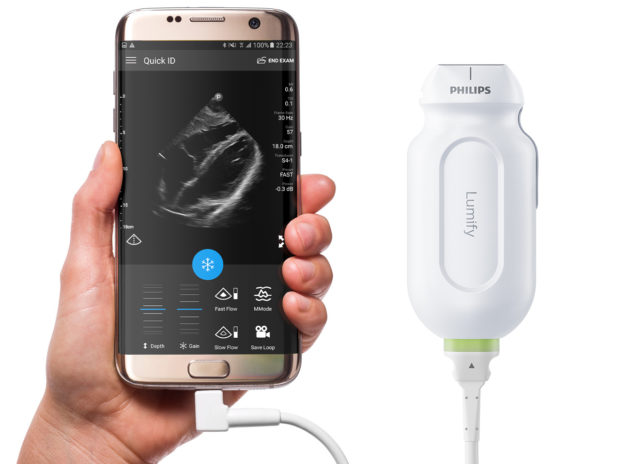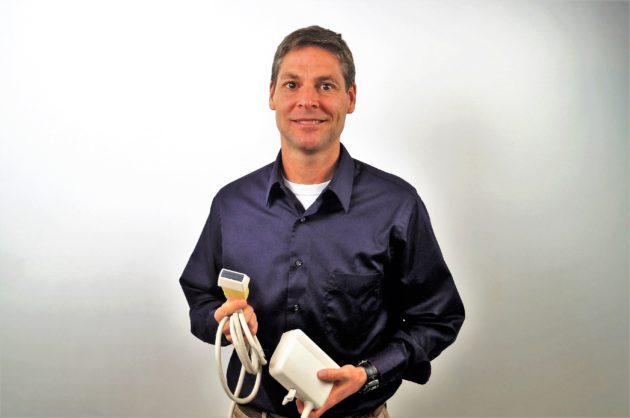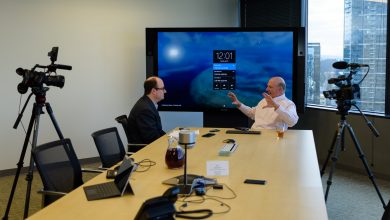The mobile ultrasound revolution: How technology is expanding this medical tool to new frontiers

Last year, a physician in a remote Polish town visited the home of a baby with a systemic bacterial infection.
The patient appeared healthy with a normal physical exam, so typically the doctor would have ended the appointment then. But since she had her new handheld ultrasound – which weighs less than a pound and hooks up to her Android smartphone ― she was able to quickly scan the child’s heart.
There, she found fluid building up in the sac containing the heart, a life-threatening emergency that required immediate hospitalization. Detecting that fluid early likely saved the child’s life, doctors told the family, according to Bothell, Wash.-based Philips Healthcare, which manufactures the Lumify she used.
Decades after Seattle led the way in portable ultrasound development, the technology has made the leap to sleek, handheld devices that can connect to a smartphone. Already, the cheaper, lightweight equipment is impacting lives throughout the world, from medical schools’ anatomy classes to isolated battlefields. Experts compare this development to the advent of tablets or smartphones in the computing world ― and they say we’ve only begun to see the implications of the mobile ultrasound era.
“This is a game-changer for people with limited resources to provide care,” said Dr. Michael Vrablik, an emergency medicine physician who works in ultrasound education at the University of Washington.
Increasingly, researchers say, ultrasound technology will be used not just for imaging but for actual treatment of disease. For example, ultrasound can create a force field akin to a “tractor beam,” to move objects around inside the body without invasive surgery, said Mike Bailey, a University of Washington associate professor and senior principal engineer in the UW’s Applied Physics Lab in the Center for Industrial and Medical Ultrasound.
And when combined with artificial intelligence, mobile ultrasound devices have the potential to become automated tools for diagnosis.
Pacific Northwest at the forefront
Seattle has long been considered a leader in the ultrasound field, said Bailey, who is part of a team of physicists and bioengineers working on new medical uses for ultrasound. He pointed to the development of the Doppler system, which can generate heart measurements and blood flow, in the 1960s.
More recently, the region played an instrumental role in the revolution to make ultrasound portable, with Bothell-based SonoSite releasing the groundbreaking battery-powered portable ultrasound in the late 1990s.
Even though new high-profile entrants like the $2,000 Butterfly iQ come from the East Coast, the Pacific Northwest is still a hotbed for handheld ultrasound developers such as Philips Lumify, SonoSite and Vancouver-based Clarius.
The handheld models represent the latest technology jump in the diagnostic technology, which for years relied on bulky – yet powerful – cart-based systems. About two decades ago, the lighter 10-pound laptop versions entered the market, trading in some computing power for increased mobility. Experts compare the latest handheld iteration to the advent of tablets or smartphones in the computing world.

Cart-based models can run up to $200,000; the laptop versions are $30-50,000; and the handhelds are under $10,000 – a game changer for accessibility, observers note. A recent report looking at portable ultrasound devices globally predicts the market will grow 8.5 percent year over year over from 2018 to 2024.
To be clear, the handheld versions aren’t a replacement for the larger models that come with heftier computing power. For example, an emergency room physician might use a handheld to quickly see if there’s a foreign body inserted into a patient, or if there’s fluid building around the lung. But a patient who needs a full ultrasound workup with measurements would likely still use the larger models.
Filling a need
Urgent care clinics, telemedicine and long-term care centers with elderly patients are areas of growth, industry observers note. Another big use is in places where even the 10-pound laptop ultrasounds are unwieldy, including military battlefields where medics could detect internal bleeding from shrapnel.
Closer to home, the University of Washington is working on an airlift study looking at the ability to diagnose severe medical issues while patients are being transported from remote locales. Stethoscopes are tough to use in the helicopter because of the loud transit noise.
The handheld ultrasound seems an optimal choice to look at problems such as pneumothoraces, where air escapes outside the lungs but remains trapped in the chest cavity. Diagnosing a patient in transit could lead to a quicker and more definitive intervention on the ground, Vrablik said.
Another UW emergency physician, Dr. M. Kennedy Hall, is the principal investigator of a research study in collaboration with NASA that is looking at using portable ultrasound technology to diagnose kidney stones on space flights.
“You can’t fly back from an extended mission to get a CAT scan,” he said.
Ensuring patient privacy
Ultrasound experts such as UW’s Bailey said there are some reservations about easy and ubiquitous use of ultrasound.
While there are ways to encrypt and store images on HIPAA-compliant servers, “there’s more risk of abuse when it’s so accessible it’s even on your own phone,” Bailey said.
As access to medical data and privacy grow, emergency medicine physician Hall predicts there will be more third-party vendors emerging to protect privacy. Hospitals might also restrict personal cell phone use.
With the technology’s proliferation, training is also incredibly important. Medical schools are adapting to the changing technological landscape by incorporating ultrasound in their medical school curriculum, including using ultrasound to teach anatomy, said Randy Hamlin, the general manager for point-of-care ultrasound for Philips.
“The next frontier we’re trying to solve is education: How do we educate new users to become skilled ultrasound users faster?” Hamlin said.
Eventually the devices might incorporate artificial intelligence so that they can guide the user’s diagnosis. Bailey has heard speculation that one day they could be available on the sidelines of a kids’ soccer matches, helping coaches determine if an injury is severe enough to pull someone from the game.
“That was the most shocking use I’ve heard of,” he said.
For now, though, the handheld capacity itself has been life-changing. As the Polish mother wrote on behalf of her son: “From the bottom of my heart, I thank you that I could spend my first birthday with my mom and dad at home.”
Listen to a conversation with Mike Bailey and journalist Kellie Schmitt on this GeekWire Health Tech podcast episode, produced and edited by Jennie Cecil Moore.
Conclusion: So above is the The mobile ultrasound revolution: How technology is expanding this medical tool to new frontiers article. Hopefully with this article you can help you in life, always follow and read our good articles on the website: Ngoinhanho101.com





